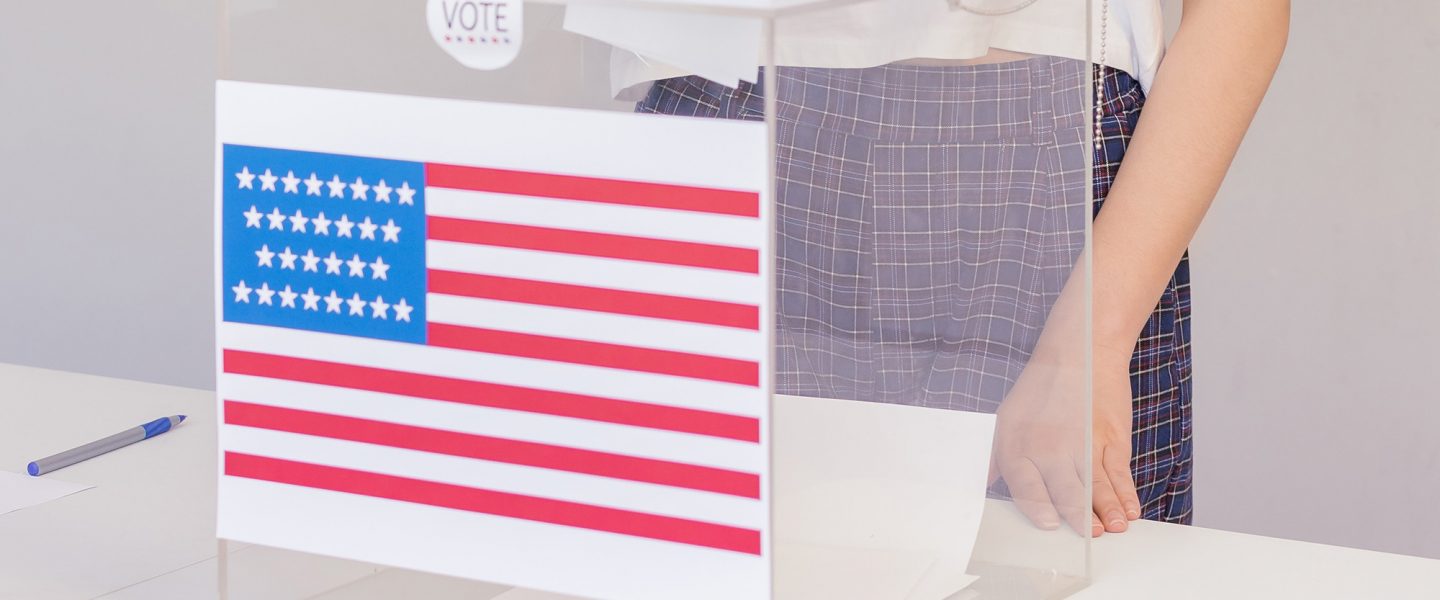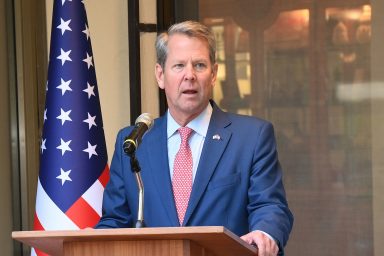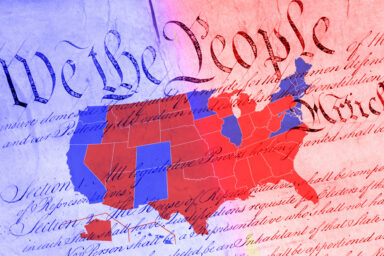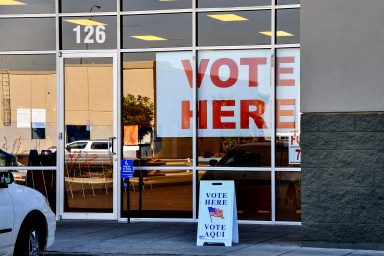Given the extent to which election transparency is in the public interest, we are all stakeholders with a constructive role to play in finding the right way to achieve it.
|
Listen To This Story
|
— Special Report From the EI Trenches —
The stark new divide between Democrats and Republicans has precipitated a crisis of trust in our democracy, underscoring the importance of finding common ground for the healing of the nation.
This crisis of trust is a function, at least in part, of a lack of belief in election results. In 2000, 2004, and 2016, Democrats doubted the results of the presidential election. Then, while Democrats, citing reports from mostly Republican government officials, hailed the 2020 election as the most secure and accurate election ever, Republican voters, spurred by Donald Trump, had election skepticism on steroids, with an enduring majority believing the election was stolen. Both sides were, and continue to be, fervently confident in their mutually exclusive beliefs.
While Democrats rightly argue that there is no evidence to suggest the election was stolen, it is important to remember that accusations of election fraud have been made in the past by both parties, albeit never to the extreme that occurred following the 2020 election. Democrats, myself included, have been complaining about the lack of transparency and security in our voting systems for two decades.
As a result of Russian interference in the 2016 election, elections were designated as “critical infrastructure.” The Department of Homeland Security assumed a role in ensuring the security of election infrastructure and combating foreign and domestic interference in January 2017.
Security increased but, concomitant with that, transparency significantly decreased. That is, a skeptical public has become more reliant than ever on officials’ and experts’ assurances of security because they can see even less for themselves. This is not good news.
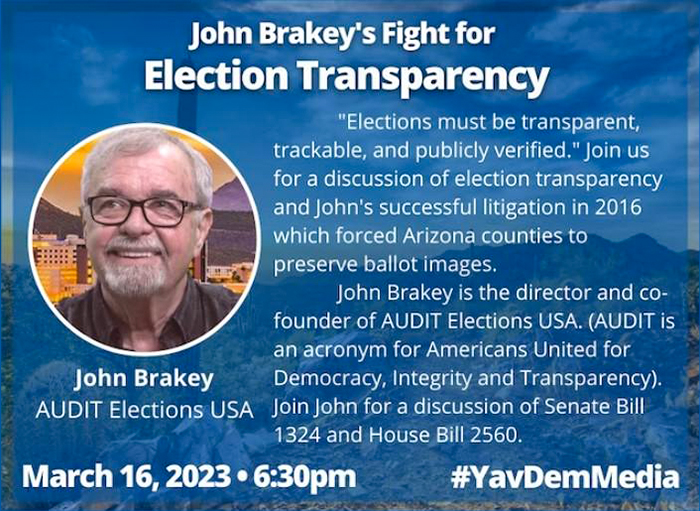
Video: Verifying the Accuracy of Election Results with Ballot Images and CVR:
The How and Why of Election Transparency
The absolute truth about what transpired in the 2020 election, as in previous elections, is unknown and will likely remain so. This uncertainty is largely a function of a lack of transparency, which prevents the public from accurately verifying or disproving election results. The inability to verify election results has created more cynicism and more distrust. This transparency deficit is a growing concern that threatens the fabric of our democracy.
One aspect of our movement away from transparency is that it is getting more difficult to obtain public records. One of many examples of this is my own request to Santa Cruz County, AZ, for a copy of the county’s 2022 cast vote record (CVR), which is a spreadsheet database that anonymously lists the votes on every ballot cast in the county. Even though the county had freely given out the cast vote record for the 2020 election, it refused to give me the 2022 CVR and then sued me just for asking. We prevailed in court and now they owe my attorney $20,000. Santa Cruz County learned the hard way that a government entity cannot sue a requester for asking for public records.
There is a misconception among some election officials and Democrats — understandably wigged out by the trauma of Donald Trump’s post-2020 Stop the Steal campaign — that releasing public records after an election will lead to crisis and chaos. In fact, just the opposite is true.
When records are given to just one entity, such as happened in 2020 with ballots and ballot images being given only to the Cyber Ninjas, then the public has no way to independently confirm or rebut anything that entity says about those records. If only election officials have the records, then the officials will say, “Trust us, the records we have show that the election was accurate.”
But if records are released to the public, particularly the CVR and the ballot images, then the public can verify the results themselves.
After all, the county possesses the original ballots, which are linked to the original ballot images that have been hash-check protected. This process safeguards against any attempts to manipulate the results during the process from start to finish, thus making the “black box” truly transparent, trackable, and publicly verified with a redundant, auditable, clean chain of ballot custody.
Just a Question of Time
In our country we have crossed the Rubicon — there is no going back to a system telling us to trust unverified elections. We cannot continue to lurch from election to election without public confidence in the results. Winners will always believe they have won, but it is vitally important for losers to believe they have lost. Confidence in election results is good for all political parties, for voters, candidates, election officials, and our country.
If citizens see that the vote counting process is concealed, taking place behind a cyber curtain in a black box, is it any great surprise that they begin to question the legitimacy of the election results and lose faith in the government, leading to profoundly negative consequences, such as political instability, civil unrest, and even violence? Really, wasn’t it just a question of time?
In Barbara F. Walter’s 2022 book How Civil Wars Start, she states:
While elections can be an important tool for reducing conflict, they must be carefully managed and conducted in a way that is fair, transparent, and inclusive of all groups in society.
She further elaborates in this NPR interview, highlighting the complex relationship between civil war, political exclusion, and elections.
Ballot Images: Our Solution to the Transparency Problem
There is a solution to this lack of transparency, one that we at AUDIT Elections USA, the advocacy NGO I co-founded, have been promoting for over a decade, and that is finally gaining traction in the US.
That solution is ballot images and CVRs being made publicly available in every state in the US — not as the sole decider of any election, but as a transparent, easy-to-access verification of election results in conjunction with other audits. This reform is embodied in legislation we have helped draft in Arizona, HB 2560, which has now passed both the House and Senate and awaits the governor’s signature.
Ballot images are digital pictures of paper ballots that are created by electronic voting machines when each ballot is scanned. These images are anonymous and do not identify individual voters. They serve as a backup record of each ballot cast, providing a way to verify the accuracy of the vote count. Ballot images can be used to review and verify vote totals, and they can also be used to identify any disparities or errors in the vote counting process.
Newer digital voting systems have been designed with a secure chain of custody that seamlessly integrates into the CVR database. This CVR accounting spreadsheet can be converted into a Ballot Image Audit (BIA) system. Conveniently, the system can sort ballot images by precinct for efficient auditing, promoting a more organized and controlled process.
The core objectives of this voting system are transparency, trackability, and public verification. For vote-by-mail (VBM) ballots, high-speed digital scanners process them, and the ballot becomes anonymous once the envelope is removed. An index number sprayed on the corner of the original ballot connects the original hand-marked paper ballot to the ballot image.
The importance of this connection is that even in the very unlikely event that a hacker managed to break through and alter ballot images — a far more difficult exploit than altering vote totals on a voting machine or central tabulator — this manipulation would be exposed immediately simply by spot-checking the ballot images against the originals.
In Arizona, VBM ballots are stored in multi-precinct batches. Fortunately, the ballot images can be easily sorted by precinct, further enhancing the public auditability of the system. This auditability feature and system redundancy ensure the secure preservation of evidence and boost confidence in the electoral process. Unlike the outdated mark sense technology system, which left no traceable evidence, digital systems enable straightforward public auditing with public records.
The Problem With the Solution
In some states, ballot images are already considered a public record and can be used for election transparency and accountability purposes. But in other states, ballot images are being opposed by either Democrats or Republicans — reflexively in many cases, without much rhyme or reason — and even being destroyed contrary to federal law.
The divide between Democrats and Republicans is now so stark and reflexive that they will often refuse to support legislation, even if it’s in their own best interest, not because they believe it’s wrong or harmful, but simply because it was proposed or sponsored by someone from the opposing political party.
In other words, if the Right goes left, then the Left goes right!
A perfect example of this illogical thinking can be found in the opposing views of Democrats and Republicans in Arizona, New York, and Florida with respect to ballot images:
- A bill just passed by the Arizona legislature has bipartisan support at the highest levels of state government. The bill — HB 2560, mentioned above and sponsored by Republican House Majority Leader Ben Toma and co-sponsored by Sen. Ken Bennett (R) — has the full support of Democratic Secretary of State Adrian Fontes. Republican legislators voted for the bill, but many Democratic legislators were opposed, not because they were against the bill on its merits, but primarily because Republicans were for it.
- In Florida, just the opposite is true. The Florida State Democratic Party is a plaintiff in a lawsuit to mandate the retention of ballot images, which are currently being destroyed in the state’s eight largest counties; but Republican legislators, who are a supermajority in Florida, have opposed the retention of ballot images.
- The four Democrats on the New York State Board of Elections are in favor of making ballot images available to the public but the four Republicans on the board are opposed, leading to a deadlock.
Navigating the Minefield
Like many long-term election activists finding themselves in this new minefield, I have had to adjust my approach. Instead of saying, “I want to find out if the election was rigged,” I now say, “I’m here to prove that the election was real.” The goal should always be to ensure that the election process is accurate, transparent, trackable, and publicly verified, rather than to confirm preexisting beliefs or agendas.
If we want to bridge the political divide, the first step in healing is to listen to and understand the perspectives of those who hold different views. Rather than being dismissive, condescending, or reactive, we should seek common ground. Legislators in every state, as well as in our nation’s capital, must learn to evaluate legislation on its merits rather than solely based on party affiliation.
As a lifelong Democrat and election expert, I participated in 2021’s Maricopa County “Fraudit” on three levels: as an observer, as a myth-buster, and in order to protect our democratic republic.
My participation was condemned by many Democrats because the audit was perceived as a partisan Republican initiative, which it was. However, my work in elections is fiercely nonpartisan. My involvement in the audit did not mean that I supported the way that particular audit was conducted, but it did mean that I was there to observe and report on the goings on and flaws in the process. I also brought in other election experts who have written extensively about problems with the audit’s procedures and conclusions.
During the audit I developed a close friendship with the Republican Senate liaison to the audit, former Arizona Secretary of State and current Arizona State Senator Ken Bennett. Through our many discussions, I provided valuable insights to Ken regarding the significance of ballot images and the CVR, which eventually led to his sponsorship of the ballot image bill in Arizona.
I was also instrumental in bringing together Bennett and Democratic Secretary of State Fontes, who, as noted, also supports the ballot image bill. If I had not participated in the Maricopa audit, the ballot image legislation may never have been proposed or supported by top state officials.
As time has elapsed, more people now understand why it was important for me to be at the Cyber Ninjas audit, but the criticism and attacks I received at the time reflect the corrosive impact of the partisan divide in our country.
Bridging the Divide to Solve the Trust Problem Together
It is important to recognize that not all those who disagree with us deserve to be condemned or ignored. Yes, there are cynics out there, and bad actors whose interest in electoral processes begins and ends with their quest for partisan advantage, favorable outcomes, winning. But there are also many individuals, on both sides of the partisan divide, whose goal is strictly to ensure the accuracy of our elections.
To achieve this goal, we must work together to prioritize transparency, trackability, and public verification in our electoral process. But we can’t cooperate in shaping our future if we refuse to stop fighting about the past. Democrats moved on from 2000 (and 2004 and 2016) and Republicans need to move on from 2020. Both parties should be able to work together on this critical issue that affects all Americans. It is time to stop crying foul over the 2020 election and move on to solutions.
Our simple and immediate solution to the trust crisis is to make ballot images and cast vote records publicly available. It was Ronald Reagan who famously said “Trust, but verify,” and that applies to our elections at least as much as it does to nuclear arsenals. With ballot images and CVRs preserved and open to the public, not only will fraud (or error) be subject to quick detection, but it would be hard to imagine a stronger deterrent to anyone thinking of rigging an election.
With hand counting generally seen as too cumbersome for the long ballots typical in US elections, verification by ballot images and CVRs provides a viable alternative to make the vote counting process public and observable, which is likely the only way to restore bipartisan trust in US elections going forward.
Election processes, I know, can seem too complex and byzantine for anyone but a dedicated expert to understand well enough to take a position about solutions. But I don’t think that is the case. Given the extent to which finding the right solution is in the public interest, we are all stakeholders in this with a constructive role to play. So let me point you to a few resources that shed light on the problem of conducting honest and accurate elections and on the surprisingly simple solution that is at hand.
We highly recommend watching the following four videos to understand why the CVR and ballot images are a critical tool for verifying election results:
- An informative explanation of the four parts of HB 2560 by Bennett and Fontes during the AZ House Election Committee hearing on 2/08/23
- Close Elections – Convincing the Loser
- See the Vote – Fight Disinformation
- How to Analyze Results in CVR by Using Microsoft Pivot
In a one-page bipartisan paper, Bennett and I present the case for making ballot images and CVRs public.
On April 4, The Washington Monthly published an article about Fontes and Bennett’s bipartisan effort to improve election integrity: “Could Ballot Images Loosen the Grip of Disinformation?”
In conclusion, we must break the cycle of nondisclosure and embrace transparency in our elections. As Albert Einstein famously said, “Insanity is doing the same thing over and over again and expecting different results.” It is time for a change, and we must now begin working together to ensure the accuracy and integrity of our electoral process.
—————————————————————————-
John Roberts Brakey is the director and co-founder of AUDIT Elections USA, a 501(c)3 that advocates and litigates for public oversight of federal, state, and local elections.
